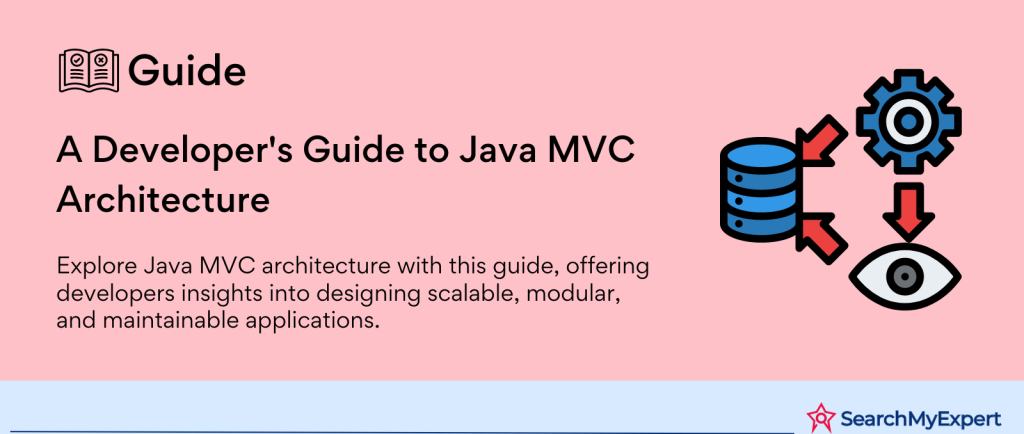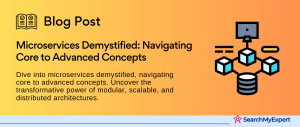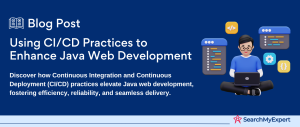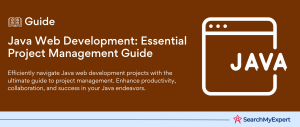MVC Architecture: A Key to Efficient Java Web Development
In the realm of web development, particularly within the Java ecosystem, the Model-View-Controller (MVC) architecture stands as a beacon of efficiency and organization. This design pattern, foundational in crafting dynamic web applications, partitions an application into three interconnected components, ensuring a clean separation of concerns. Understanding MVC is crucial for developers who aim to create scalable and maintainable web applications, especially when working with Java frameworks like Spring MVC.
Understanding the Core Components of MVC
Model:
- Definition: The Model represents the data and the business logic of the application. It is responsible for accessing and modifying the data, and encapsulates the core functionalities and data of the application.
- Key Characteristics:
- Data Management: Handles data logic and interacts with the database.
- Business Logic: Encapsulates the rules of the application.
View:
- Definition:
The View is the user interface of the application. It displays data to the user and sends user commands to the controller. - Key Characteristics:
- User Interface: Renders data and presents the interface to the user.
- User Interaction: Facilitates user interaction and input.
Controller:
- Definition:
The Controller acts as an intermediary between the Model and the View. It listens to user inputs and interactions from the View, processes them (often with the help of Model), and returns the output display to the View. - Key Characteristics:
- Request Handling:
Manages user requests and delegates tasks. - Data Processing: Processes data and determines the next course of action.
Benefits of MVC Architecture Over Traditional Approaches
- Enhanced Separation of Concerns:
MVC distinctly separates the application’s data layer, logic, and UI, which simplifies the development and maintenance process. - Facilitated Team Development: Different teams can work simultaneously on each component without substantial overlap, increasing efficiency.
- Improved Scalability: Due to its modular nature, applications built with MVC are more scalable and adaptable to new requirements.
- Ease of Testing:
Independent components allow for easier unit testing and debugging. - Flexibility in Development:
Developers can change the UI or business logic without affecting other parts of the application.
MVC in Java Web Development: The Relevance of Spring MVC
In Java web development, MVC architecture plays a pivotal role, particularly illustrated by the Spring MVC framework. This framework, part of the larger Spring ecosystem, provides comprehensive infrastructure support for developing robust Java web applications following the MVC pattern.
- Spring MVC Framework:
It integrates seamlessly with other Java technologies, offering developers a powerful toolkit to build efficient, scalable web applications. - Advantages for Java Developers: Leveraging the MVC architecture in Java development, especially through Spring MVC, leads to more organized, efficient, and maintainable codebases.
The Model Layer: The Backbone of Data Management in MVC Architecture
The Model layer, a fundamental component of the Model-View-Controller (MVC) architecture, plays a crucial role in managing the data and business logic of an application. In the context of Java web development, understanding the Model layer’s responsibilities, types of models, and its role in encapsulating data and business logic is essential for building robust and efficient applications.
Responsibilities of the Model Layer in Data Management
Data Storage and Retrieval:
- The Model interacts directly with the database or any data source.
- It handles CRUD (Create, Read, Update, Delete) operations, ensuring data persistence.
Business Logic:
- Encapsulates the core functionality and rules of the application.
- Processes data and enforces business rules and validations.
Data Representation:
- Structures and organizes data in a format that can be used by other layers.
- Transforms raw data into a more accessible and usable form.
Notification of Changes:
- Informs the View of any changes in the data so that the UI can be updated accordingly.
- Implements observer patterns for efficient data synchronization.
Types of Models in Java
POJOs (Plain Old Java Objects):
- Simple Java objects that encapsulate data without imposing any restriction or framework.
- Used to represent data entities and their attributes.
DAOs (Data Access Objects):
- Specialized objects focusing on data access logic.
- Abstracts and encapsulates all access to the data source.
Service Models:
- Represent the business logic layer.
- Contains business rules and logic that define operations on the data.
Encapsulation of Data and Business Logic
Separation from Presentation Layer:
- By encapsulating data and logic, the Model ensures a clear separation from the View (presentation layer).
- This separation allows changes in business logic or data handling without affecting the user interface.
Data Security and Integrity:
- Encapsulation helps in maintaining data security and integrity.
- Only exposed methods can be used to interact with the data, reducing the risk of unintended modifications.
Reusability and Maintenance:
- Encapsulated models are reusable across different parts of the application.
- Maintenance and updates become easier and localized.
Example in Java Web Development:
- In a Java web application, a POJO might represent a user with properties like username and password.
- A DAO might handle database interactions for user data, like retrieving user information.
- A Service Model would implement the business logic, such as validating user credentials.
The View Layer: Crafting the User Interface in MVC Architecture
In the Model-View-Controller (MVC) architecture, the View layer is pivotal in presenting information to the user. It is responsible for rendering data and managing user interactions, acting as a bridge between the application’s backend and the user’s experience. For Java web development, a variety of view technologies are available, each offering unique features and benefits. Understanding these technologies and the View layer’s role in displaying data and handling interactions is crucial for creating intuitive and effective user interfaces.
Role of the View Layer in Presenting Information
Data Rendering:
- The View layer takes data from the Controller and renders it to the user.
- It is responsible for presenting the data in a user-friendly format.
User Interface Design:
- Involves the layout, design, and navigation of web pages or application screens.
- Focuses on aesthetic aspects to enhance user experience.
Interaction Handling:
- Manages user inputs and actions, such as clicks and data entry.
- Sends these interactions back to the Controller for further processing.
Exploring Different View Technologies in Java
JavaServer Pages (JSP):
- A server-side technology that allows for the creation of dynamic, platform-independent methods for building Web-based applications.
- JSP pages are easy to write and maintain, similar to HTML pages but with the ability to embed Java code.
Thymeleaf:
- A modern server-side Java template engine for web and standalone environments.
- Known for its natural templates, allowing for static prototyping without the need for a back-end.
FreeMarker:
- A template engine that uses data models and templates to generate output text, mainly HTML web pages.
- Highly flexible, with a strong emphasis on MVC principles.
Demonstrating How Views Display Data and Handle Interactions
Data Display Mechanism:
- The View receives data models from the Controller.
- It then uses the selected view technology (like JSP, Thymeleaf, or FreeMarker) to embed this data within the HTML content.
User Interaction Flow:
- User actions on the View layer trigger events (like form submissions).
- These events are routed back to the Controller, which then processes the data or user request.
Example in Java Web Development:
- In a Java web app using JSP, a user’s request for a product list is sent to the Controller.
- The Controller fetches product data from the Model and sends it to a JSP page.
- The JSP page then formats and displays this product list to the user.
The Controller Layer: Orchestrating User Requests in MVC Architecture
In the Model-View-Controller (MVC) framework, the Controller layer is the central conductor, managing the flow of information and control logic between the Model and the View. Its primary role is to handle user requests, process data, and ensure the appropriate response is rendered by the View. In Java web development, Controllers are instrumental in creating responsive, efficient, and user-friendly applications. Understanding their functionalities, such as routing, form processing, and error handling, is key to leveraging the full potential of the MVC architecture.
The Controller’s Role in MVC Architecture
Handling User Requests:
- Receives user inputs and interactions from the View.
- Determines the course of action based on the request type and content.
Coordinating Between Model and View:
- Acts as an intermediary, ensuring a clear separation between the application’s data and its presentation.
- Directs the flow of data from the Model to the View and vice versa.
Common Functionalities of Controllers in Java Web Development
Routing:
- Manages the paths and endpoints for user requests.
- Determines which function or method to execute based on the URL accessed.
Form Processing:
- Handles data submitted by users through forms.
- Validates and processes form data before passing it to the Model.
Error Handling:
- Manages errors and exceptions that occur during request processing.
- Ensures users receive appropriate feedback in case of errors.
Illustration of Controllers in Action
Receiving Requests:
- A user submits a form on a web application.
- The Controller receives this request and decodes the information.
Interacting with the Model:
- The Controller validates the user input and sends it to the Model for further processing, like database interactions.
- It then waits for a response from the Model, which could be data or a confirmation of a successful operation.
Updating the View:
- Once the Controller gets the necessary data or status from the Model, it selects the appropriate View.
- The View is then updated or rendered with the new data, and the response is sent back to the user.
Navigating the Data Flow in MVC Architecture: A Java Perspective
Understanding the data flow in the Model-View-Controller (MVC) architecture is crucial for developing efficient Java applications. This architecture, renowned for its separation of concerns, ensures that different aspects of the application – data handling, business logic, and user interface – are independent yet seamlessly integrated. Let’s walk through the typical data flow within a Java MVC application, highlighting how user interactions trigger data retrieval, processing, and the subsequent update in presentation.
Typical Data Flow in a Java MVC Application
User Interaction Triggering the Process:
- Begins with the user interacting with the application (e.g., clicking a button).
- This interaction is captured by the View and relayed to the Controller.
Controller’s Role in Processing the Request:
- The Controller receives the user request and understands the required action.
- It then communicates with the Model to request the necessary data or action.
Model’s Responsibility in Data Management:
- The Model accesses the data source (like a database) and performs the required operations.
- Once the data is processed or retrieved, it is sent back to the Controller.
Updating the View with New Data:
- The Controller receives the updated data from the Model.
- It then selects the appropriate View and passes the data to it.
View Renders the Updated Information:
- The View uses the data to update the user interface accordingly.
- The user sees the updated information or the result of their interaction.
Example Scenario: Data Flow in Action
Scenario: User Requests to View a Product List
- User Action:
The user clicks on ‘View Products’ in the web application. - Controller Receives Request:
The request is sent to the Controller which identifies it as a request to fetch product data. - Model Interaction: The Controller communicates with the Model, which then retrieves the product list from the database.
- Data Returned to Controller:
The Model sends the product list back to the Controller. - View Update:
The Controller forwards this data to the View, which then renders the product list for the user.
Emphasizing Separation of Concerns
Distinct Responsibilities:
- Each component (Model, View, and Controller) has a clear, separate role.
- This separation reduces complexity and enhances maintainability.
Independent Development and Testing:
- Components can be developed and tested independently, improving development efficiency.
- Changes in one component (like the data model) do not directly affect others (like the View).
Flexible and Scalable Architecture:
- MVC architecture allows for scalability and flexibility in application development.
- It facilitates easy updates and modifications to the application.
Enhanced Collaboration:
- Different teams can work on each layer separately, streamlining the development process.
Benefits and Challenges of MVC Architecture in Java Development
The Model-View-Controller (MVC) architecture has become a mainstay in the world of Java development, recognized for its ability to create clear, efficient, and scalable web applications. While the benefits of MVC are numerous, like any architectural pattern, it also presents certain challenges. In this exploration, we will recap the key benefits of using MVC in Java development, delve into the potential challenges it poses, and offer practical tips for effectively utilizing and overcoming these challenges.
Key Benefits of MVC in Java Development
Maintainability:
- MVC’s separation of concerns makes it easier to manage and update applications.
- Each component can be maintained independently, reducing the risk of unintended side effects.
Modularity:
- MVC promotes a modular approach to application development.
- This modularity facilitates easier and more efficient team collaboration.
Testability:
- Independent components allow for more straightforward unit testing.
- The isolation of business logic from the user interface enhances the accuracy and effectiveness of tests.
Scalability:
- The MVC pattern adapts well to growing applications.
- New features and functionalities can be integrated with minimal disruption to the existing codebase.
Improved Performance:
- Efficient data handling and rendering logic contribute to better application performance.
- MVC applications can handle large amounts of data and user requests more effectively.
Potential Challenges in MVC
Complexity in Large Applications:
- As applications grow, the MVC architecture can become complex and challenging to navigate.
- The interdependencies between components might lead to confusion and increased complexity.
Debugging Overhead:
- Tracing through the different layers (Model, View, Controller) to find issues can be time-consuming.
- The separation of concerns, while beneficial, might complicate the debugging process.
Learning Curve:
- New developers might find the MVC architecture challenging to grasp initially.
- Understanding how components interact within MVC requires a solid grasp of the pattern.
Tips for Overcoming Challenges and Utilizing MVC Effectively
Embrace Modular Development:
- Develop features as self-contained modules to reduce complexity.
- Encourage team members to focus on specific areas (Model, View, or Controller).
Implement Robust Debugging Techniques:
- Use integrated development environments (IDEs) that support MVC frameworks.
- Utilize logging and breakpoints effectively to trace and diagnose issues.
Continuous Learning and Training:
- Provide training and resources for developers new to MVC.
- Encourage a culture of continuous learning and collaboration.
Effective Documentation:
- Maintain clear and comprehensive documentation of the application structure and flow.
- Use diagrams and flowcharts to illustrate the interactions between components.
Leverage Framework Features:
- Utilize the full range of features provided by MVC frameworks like Spring MVC.
- Explore built-in tools for testing, debugging, and performance optimization.
Iterative Development and Feedback:
- Adopt an iterative development approach.
- Regularly gather feedback from users and team members to guide improvements.
MVC Architecture in Java: Key Takeaways and Further Exploration
As we conclude our comprehensive journey through the Model-View-Controller (MVC) architecture in Java, it’s vital to reflect on the key takeaways and encourage further exploration into this indispensable design pattern. MVC is not just a framework but a philosophy that shapes the way Java web applications are designed and implemented. It provides a structured approach, enhancing both the development process and the resulting application.
Summarizing the Key Takeaways of MVC in Java
Clear Separation of Concerns:
- MVC divides an application into three main components (Model, View, Controller), each with distinct responsibilities. This separation streamlines development and maintenance.
Enhanced Scalability and Maintenance:
- The modular nature of MVC makes Java applications scalable and easier to maintain. Changes in one component generally do not affect others.
Improved Collaboration and Flexibility:
- Different teams can work on separate components simultaneously, boosting productivity and flexibility in handling new requirements.
Facilitated Testing and Debugging:
- Independent components allow for more focused and efficient unit testing and debugging, leading to more robust applications.
Responsive User Interaction:
- MVC architecture supports dynamic and interactive user interfaces, enhancing the user experience.
Advanced MVC Concepts and Related Frameworks
Spring MVC:
- A part of the broader Spring framework, Spring MVC stands out for its powerful features in building complex, enterprise-level Java applications.
- It offers advanced functionalities like REST APIs, security, and data binding.
Microservices and MVC:
- The principles of MVC can be extended to microservices architecture, where each service can follow MVC patterns.
Hybrid MVC Approaches:
- Combining MVC with other design patterns for specific project requirements can lead to more optimized solutions.
Encouraging Further Exploration and Learning
Utilizing Online Resources:
- Numerous tutorials, documentation, and courses are available online for in-depth learning about MVC and frameworks like Spring MVC.
Community Engagement:
- Participating in forums and communities (like Stack Overflow or GitHub) can provide real-world insights and problem-solving techniques.
Hands-on Practice:
- Building small to medium-sized projects using MVC and related frameworks can solidify understanding and skills.
Staying Updated:
- The field of Java development is constantly evolving. Keeping up with the latest trends and updates in MVC frameworks is crucial.
Conclusion:
In our exploration of the Model-View-Controller (MVC) architecture in Java, we’ve navigated through its core principles, dissecting each component and their interconnected roles. From the data-centric Model, the interactive View, to the orchestrating Controller, MVC stands as a paradigm of efficient software design. We’ve seen how this architecture brings clarity and structure to Java web applications, promoting maintainability, modularity, and testability.
Unleash your project’s potential with Java Development Service.
Table of Contents
Toggle






